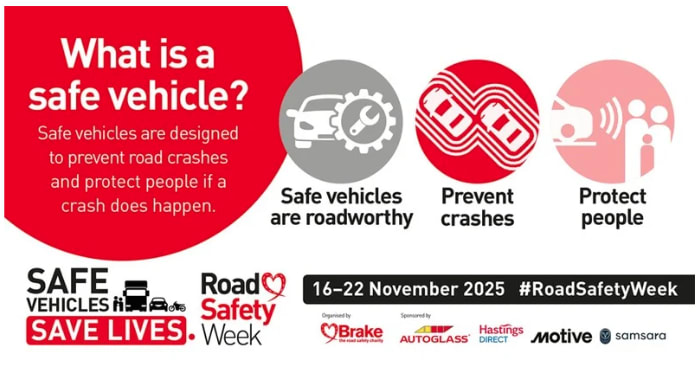First Facts: Road Safety Standards

What are Road Safety Standards?
Road safety standards are formal rules and technical specifications established to guide the design, construction, and maintenance of roads, road furniture, vehicles, and pedestrian environments.
They ensure that every aspect of the transport network—from signage and lane markings to barriers and crossings—is engineered to provide maximum safety for all road users.
By enforcing consistent requirements for visibility, structural strength, durability, and overall performance, these standards help create safer, more reliable, and accessible public highways, urban streets, and pedestrian areas, reducing the risk of accidents and improving traffic efficiency.
| Framework | Role | Key Documents |
| Legislation & Rules | Legal requirements for road user behaviour, vehicle construction, and traffic control. | The Highway Code, Road Traffic Act, Traffic Signs Regulations and General Directions (TSRGD) (specifies the design and placement of all road signs and markings). |
| Highway Infrastructure | Technical specifications for the design, construction, and maintenance of motorways and trunk roads. | Design Manual for Roads and Bridges (DMRB) (requirements and advice for road design), Manual of Contract Documents for Highway Works (MCHW) (suite of specification documents for construction contracts). |
| British Standards (BS) | Detailed, independent specifications for products and materials used in highway works to ensure quality, safety, and compatibility. | BS 7818, BS EN 12899 (fixed vertical road traffic signs), BS 8442 (miscellaneous road traffic signs and devices). |
Why does Road Safety Matter?
More than 1,700 people die and around 30,000 are seriously injured on UK roads each year (Brake 2025). Brake believes that there are a range of ways we can help the safety of all on the roads, and below is why it is so important to have road safety.
- Road safety standards reduce accidents by guiding the safe design and maintenance of roads, signs, barriers, and pedestrian areas.
- They protect pedestrians, cyclists, and vehicle occupants through effective layouts, restraint systems, and proper traffic separation.
- These standards ensure consistent compliance with government and highway authority requirements across all public spaces.
- By specifying high-quality materials and tested designs, they improve durability and reduce long-term maintenance costs.

What are BS 7818 Standards?
BS 7818:1995 is the British Standard for the design, performance, material quality, and installation of metal pedestrian restraint systems such as pedestrian guardrails used along roads, crossings, bridges, and footways.
What is the Purpose of BS 7818?
- Prevent pedestrians from accidentally entering the carriageway.
- Improve road safety in high-risk or high-traffic areas.
- Provide predictable, safe, and durable guardrail systems for public highways.
Where does BS 7818 apply?
- Near road crossings
- At junctions and roundabouts
- Along footways beside busy or fast-moving roads
- On bridges or elevated walkways
- Near schools, transport hubs, and high-footfall areas
Key Requirements of BS 7818?
- Only metal systems (typically steel or aluminium)
- Requirements for corrosion protection (e.g., galvanising)
- Bar spacing typically around 110 mm centre-to-centre (may vary by system type)
- Smooth, rounded edges—no sharp points
- Guardrails must resist specified horizontal and vertical loads
- Panels designed to allow clear sightlines between drivers and pedestrians
- Visibility gaps permitted in certain designs to improve safety at crossings
- Defined methods for fixing posts (e.g., concrete “dig-in” foundations)
- Coatings must protect against weather, rust, and long-term wear
Products Available from First Fence that Meet BS 7818 Standards
Pedestrian Guardrail
Available widths:
Pedestrian Guardrail with Visibility Gap
Available widths:
Road Safety Week
Road Safety Week is Brake’s biggest annual UK campaign, running every November to raise awareness of road danger and push for safer vehicles and road systems.
Brake believes that every road crash is a preventable tragedy. They believe in a world where no one is killed or harmed on a road. Safe vehicles can help us get there…
This Road Safety Week, Brake wants to make sure that every time we get in a vehicle we are as safe as possible, whoever we are and however we travel.
Because safe vehicles save lives!
What is a safe vehicle?
Safe vehicles are designed to prevent road crashes and protect people inside and outside the vehicle if a crash does happen.
Safe vehicles…
Prevent crashes - Automated driver assistance systems keep vehicles in the right lane and below speed limits, detect hazards and brake in an emergency.
Protect people inside and outside the vehicle - Seatbelts, airbags and ‘forgiving’ vehicle parts protect people inside and outside the vehicle in a crash. Vehicles must pass stringent crash tests.
Manage driver safety - Vehicle technology detects unsafe driving behaviour (e.g. due to tiredness) and informs authorities.
Are roadworthy - Vehicles are maintained to the highest standards and drivers carry out checks before every journey.
Record crashes - Event data recorders record what happens in a crash and notify emergency services immediately.
Safe vehicles are an important part of the safe systems approach to road safety – a shared approach to prevent death and serious injury from road crashes.
Road Safety Week 2025 will take place from 16 to 22 November 2025
Contact Us
If you have any questions or want to know more about our road safety products, please contact us. Our friendly First Fence experts are available by phone on 01283 512 111 or email sales@firstfence.co.uk. You can also connect via our live chat service for quick questions and answers.
Download our PDF version of First Facts: Road Safety Standards.












